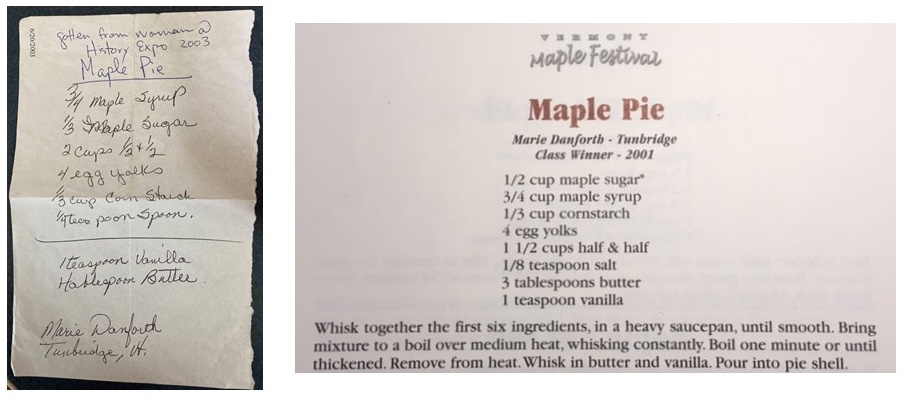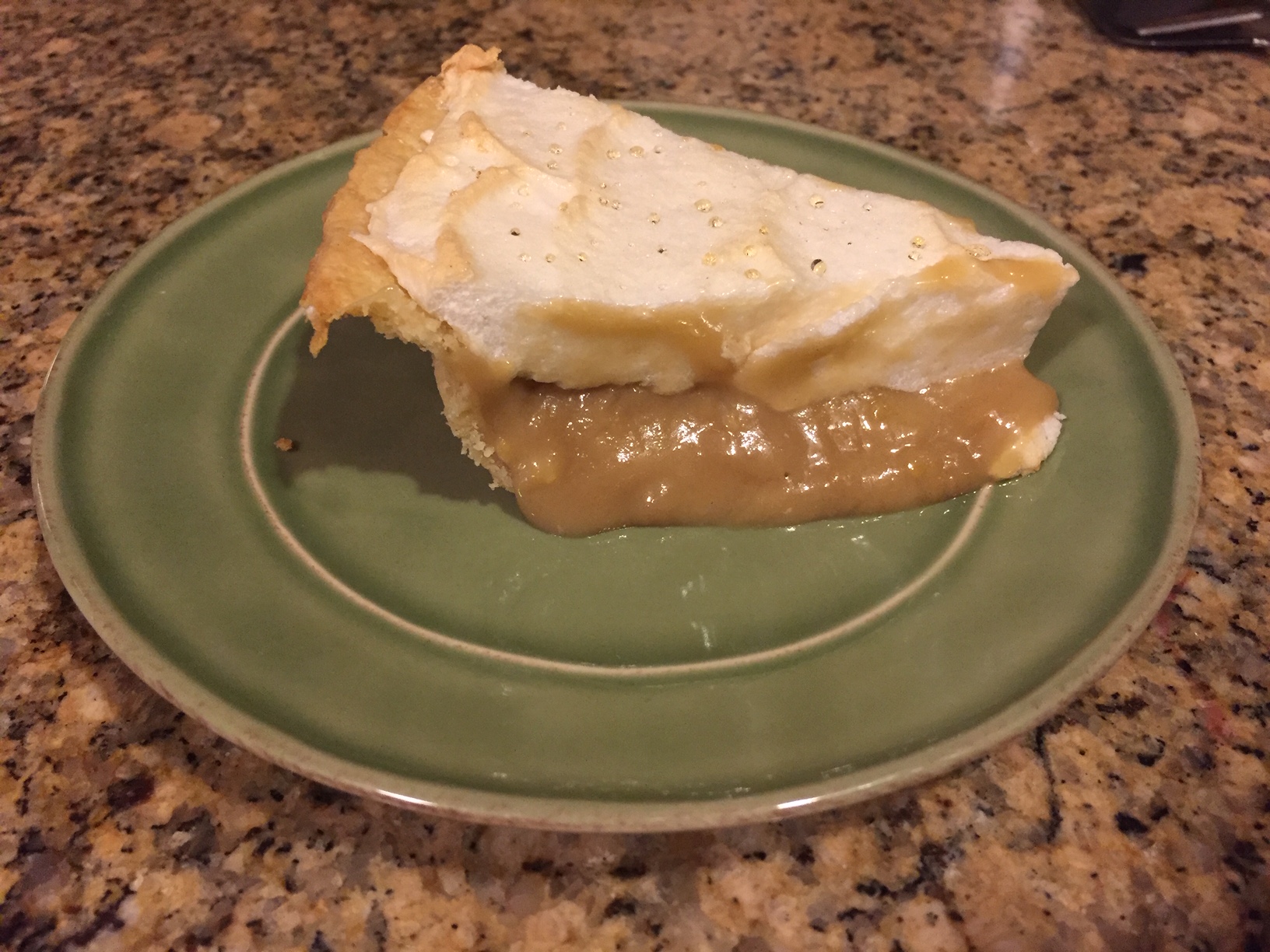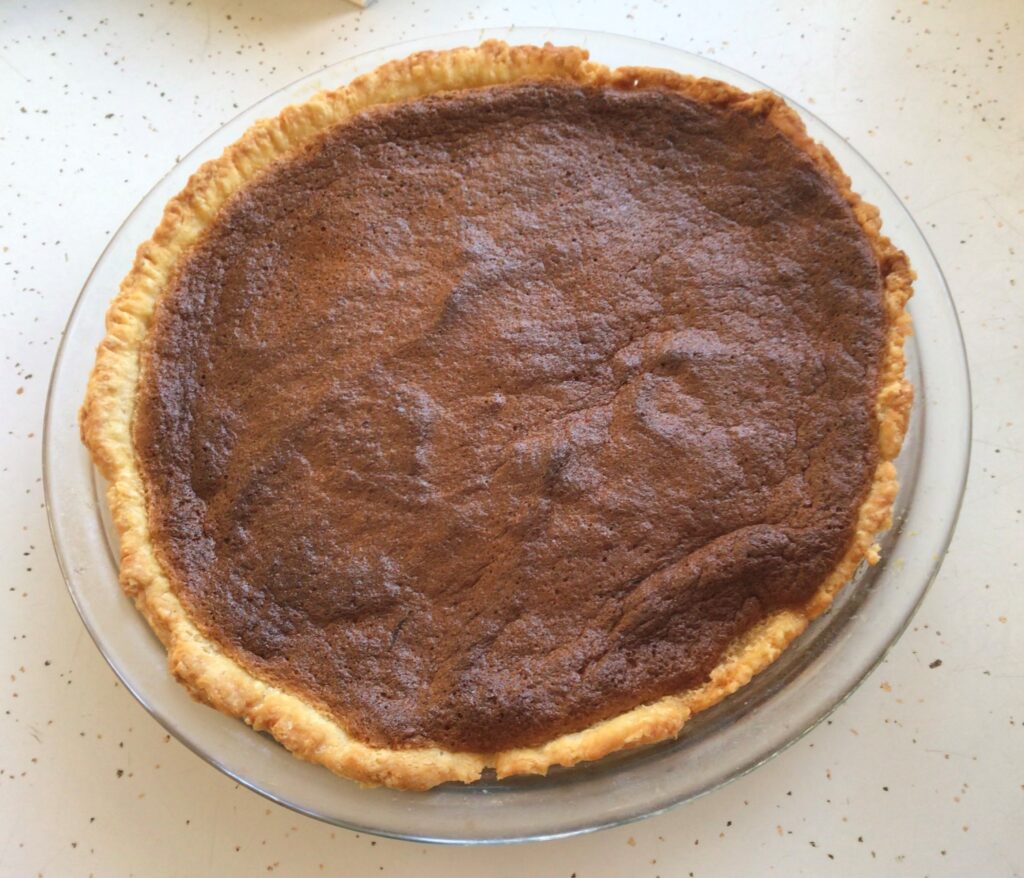When we developed an outline for a series of blog posts on making recipes from Vermont cookbooks, we quickly agreed that we should feature maple recipes in March, and more specifically, we should bake pies to celebrate Pi Day on March 14.
We found an abundance of maple pie recipes in cookbooks dedicated to maple, in community cookbooks, and in cookbooks written by chefs and food writers. One of the oldest, Maple Sugar Cook Book, was published by the Vermont Maple Sugar Exchange in 1888 to promote the use of pure Vermont maple sugar and syrup in everyday cooking. The Maple Exchange ran a contest to gather recipes and selected the best for the small 43-page cookbook. The collection includes 28 pie recipes, mostly fruit pies sweetened with maple sugar. In contrast, the 30 pie recipes in the Vermont Maple Festival’s 2005 Maple Cookbook mostly call for syrup. Maple sugar, despite the hopes of the Maple Exchange members, has become a luxury ingredient that is harder to find.

After eating an outstanding maple pie at the 2003 Vermont History Expo, Special Collections staff member Ingrid Bower asked the baker for the recipe (left). The 2005 Vermont Maple Festival cookbook confirms that the recipe is a winner (right).
We discovered that bakers take different approaches to maple pie. The sweetener might be 100 per cent maple syrup, but it could also be maple sugar or syrup combined with brown sugar. Some recipes require baking, while others use a cooked custard in a prebaked shell. In Real Old-Time Yankee Maple Cooking (1969), Beatrice Vaughan offers a no-bake Maple Chiffon Pie that relies on gelatin to produce a rich dessert. There are pies with nuts, usually walnuts, and without. One of the maple pie recipes in The Common Ground Dessert Cookbook (1998) substitutes finely ground sunflower seeds for nuts. While most recipes call for a white flour crust, the Common Ground maple pies use a whole wheat pastry crust and several recipes called for a crumb bottom crust or a crumb top layer.
Some ingredients were unexpected. A number of recipes add small amounts of vinegar because, as Mapletown’s Vermont Maple Syrup Cookbook explains, “it cuts the sweetness and brings out the maple flavor.” One of the two recipes in Westford’s Treasured Recipes includes oatmeal and coconut, a variation that popped up surprisingly often. An unorthodox frozen Maple Nut Mousse Pie in the Official Vermont Maple Cookbook calls for the typical syrup, eggs, and walnuts but uses a ready-made chocolate cookie pie shell, non-dairy whipped topping and shavings of semi-sweet chocolate.
Librarians Jeff Marshall and Prudence Doherty volunteered to select recipes and bake the pies this month. Here are their sweet reports.
Jeff Marshall: Making a Maple Cream Pie
I’ve been baking pies for a long time—since before I discovered it’s a great way to win friends and influence people—but I’ve never attempted a maple cream pie until last weekend. There are many variations within the hundreds of Vermont cookbooks so I chose a fairly simple one at random: Minnie Neun’s recipe in Northfield Now and Then: Cookbook (compiled by Betty S. Piper and others for Northfield Community Enterprises, 1970).
Minnie’s recipe uses a cup of milk, not cream, which should be heated up in a double boiler with an equal amount of dark maple syrup (nowadays “dark” is always paired with “robust flavor”). To help thicken the mixture, a separate mixture of 3 heaping tablespoons of flour, 2 egg yolks, a teaspoon of sugar, and a dash of salt is added to the hot milk & syrup mixture. The egg mixture, I found, needs some careful mixing to avoid flour lumps. Once this is cooked to the desired thickness a tablespoon of butter and a dash of black pepper are added, and the mixture is poured into a previously baked shell.
 I found the instructions for the meringue topping insufficient for someone who has never made it before, so I looked up a recipe to be sure I was doing it right. Once topped, the pie goes into the oven at 350o just long enough to brown the meringue peaks.
I found the instructions for the meringue topping insufficient for someone who has never made it before, so I looked up a recipe to be sure I was doing it right. Once topped, the pie goes into the oven at 350o just long enough to brown the meringue peaks.
The result: a very tasty, very mapley pie—“amazing!” as my co-taster remarked. I found that the filling doesn’t “set” much after it cools off, so my pie turned out just a bit runny. The black pepper adds a surprising dimension to the flavor that I found pleasing, though it is probably best to use well-ground pepper if you want to avoid that unexpected pepper spike.
Prudence Doherty: Shaker Boiled Cider Pie
I picked the Shaker Boiled Cider Pie recipe from the 2001 edition of Ken Haedrich’s Maple Syrup Cookbook, attracted by his praise for a “rich maple-apple custard with a very thin layer of meringue on top.” After reading Mrs. G. W. Winchester’s recipe for boiled cider pie in the 1888 cookbook mentioned above—”piece of butter size of a walnut, one egg, two crackers, five tablespoons maple sugar, three or four of boiled cider according to strength, little nutmeg”—I was glad to follow the detailed instructions of a modern recipe.
I used boiled cider made in Springfield, Vermont since 1882 by the Woods family. The syrup was graded as dark color with robust taste, described by many as exhibiting caramel undertones. For the crust, I used Haedrich’s Flaky Butter Crust recipe, which includes a small amount of lemon juice and calls for freezing the pastry before filling it with the custard. I appreciated that I only needed to heat the syrup, the cider and two teaspoons of butter until the butter melted—no stirring until thick—and then whisk in the egg yolks and fold in the stiffly beaten egg whites.
The pie had a great flavor, sweet and tangy, and we could definitely detect apple from the boiled cider and caramel from the syrup. Sadly, the pie was just too sweet for me. We topped second slices with vanilla ice cream, which helped balance the sweetness. Like Haedrich, we preferred the pie after it had been refrigerated.


